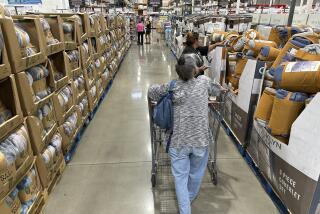China’s Economy Surges 9.5%; Overexpansion Worries Intensify
- Share via
China’s economy maintained its blazing pace of growth in the second quarter, government officials reported today, confounding analysts’ expectations of a slowdown and increasing concerns about overexpansion that could lead to a crash landing.
Officials in Beijing said the Chinese economy expanded by 9.5% in the second quarter over the year-ago period, essentially unchanged from the growth rate in the first quarter and all of 2004. Economists had expected growth of about 9%, and the Beijing government’s goal has been to engineer a “soft landing” that eventually would put growth closer to 8%.
The higher-than-expected pace came despite government efforts to cool rampant growth in factories and in real estate by imposing lending restrictions and capital gains taxes in overheated markets such as Shanghai. The government said total investment in assets such as land and factories rose by more than 25% in the first half of 2005 compared with a year ago.
The sustained, rapid expansion suggests that the world’s seventh-largest economy will continue to drive growth globally, particularly in neighboring Asian Pacific countries that have come to rely on China to buy their exports and prop up prices of commodities, industrial machinery and other goods.
At the same time, China’s inability to temper what some economists view as runaway growth poses challenges for Beijing. The central government has applied many top-down measures, so far to little avail, and analysts say factory expansions and increasingly inflated real estate prices are creating bubble-like conditions that could burst and create complications not only for Beijing but also for the global economy.
In releasing the data today, China’s National Bureau of Statistics said of the economy: “The overall situation is good.”
But Zuo Xiaolei, an economist at China Galaxy Securities Co., said the growth in China’s gross domestic product might indicate that the government is losing control over capital inflows, especially as cities and regions remain eager to attract foreign investment.
Like other analysts, Zuo was expecting GDP growth of 9% and was surprised by today’s report.
On the other hand, Zuo said, the growth may be the byproduct of a pickup in other sectors, such as consumer products, which she regarded as less threatening to China’s economic stability. In the first half, China’s retail sales surged 13% compared with a year earlier and consumer prices rose a modest 2.3%.
Today’s report, though, will almost certainly provide more fodder for economists at home and in the West who have urged China to reform its currency policy. The value of China’s yuan has been tightly pegged to the U.S. dollar, but some economists say that by moving toward a free-floating currency, Chinese policymakers would have greater ability to control the economy and the pace of its growth.
Some analysts are expecting China to take a step toward unshackling its currency in August.
U.S. politicians, in particular, have railed at Chinese economic policies, saying the present currency structure and other practices give China an unfair advantage in global markets.
Today’s report is unlikely to quell that outcry, as China’s export growth contributed to the overall increased economic activity. In the first half of this year, China’s exports increased at about twice the rate of growth for imports, resulting in a $39-billion trade surplus.
Zuo, the economist, however, said Americans should not fret about certain industries, such as clothing, that have been a source of friction. She said there was little new investment in China in such trade-sensitive sectors.
Lu Hongjun, president of the Shanghai Institute of International Finance, said the economic data for the first half of this year might not take into full account all the government cool-down measures. Some efforts to control the property market and producers of raw materials such as steel took effect only recently.
“I would expect that results won’t show up until the end of this year or early next year,” he said.
*
Cao Jun of The Times’ Shanghai bureau contributed to this report.
More to Read
Inside the business of entertainment
The Wide Shot brings you news, analysis and insights on everything from streaming wars to production — and what it all means for the future.
You may occasionally receive promotional content from the Los Angeles Times.











